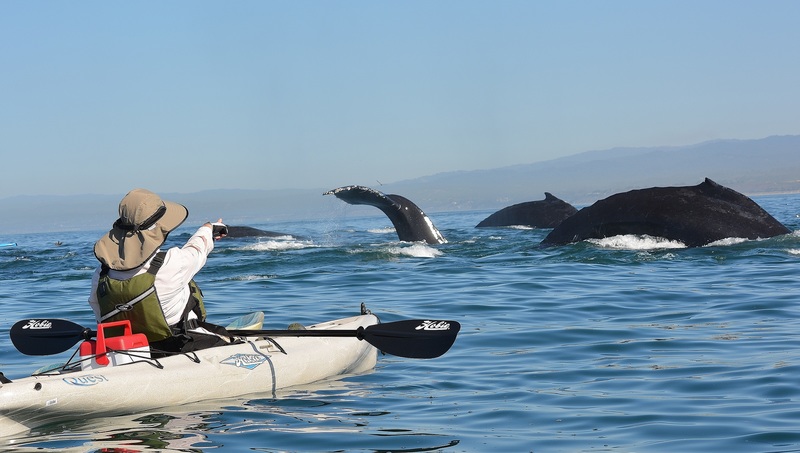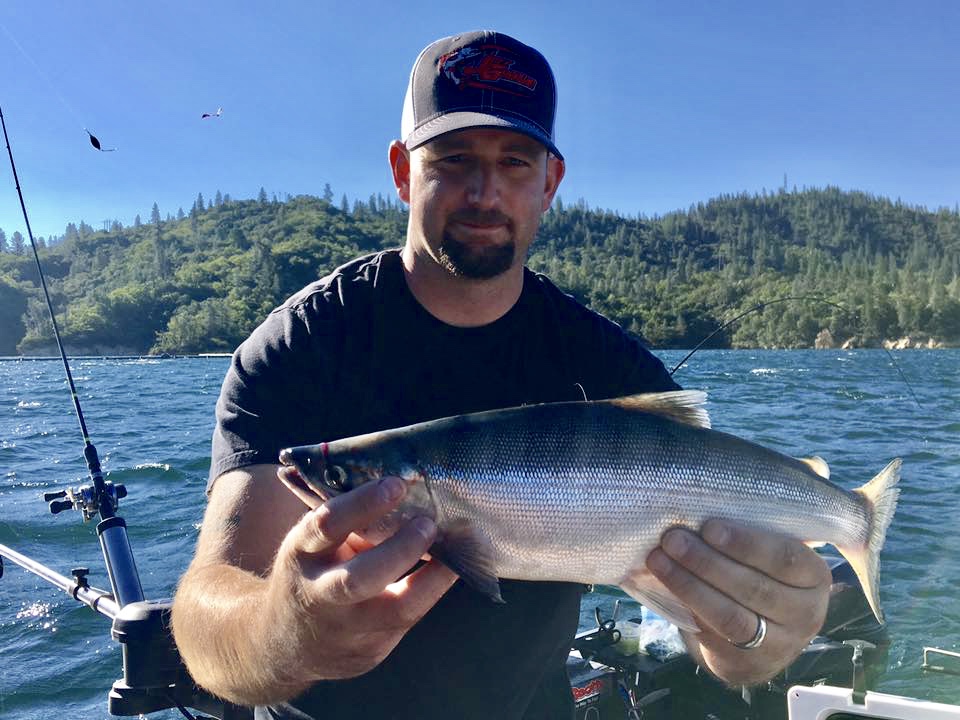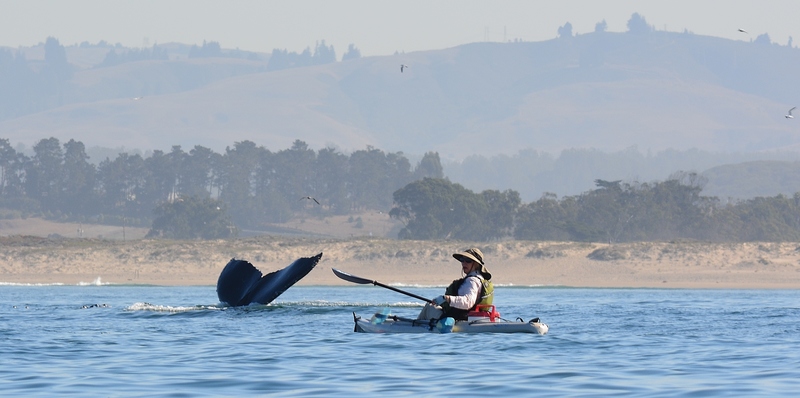Tiny Fish and Gentle Giants

by Steven T. Callan
9-9-2017
Website
My wife, Kathy, and I are in Pacific Grove this week. While we’re here, I’d like to share one of my favorite outdoor columns, about a once-in-a-lifetime wildlife encounter we had here in September 2015. This piece was originally posted as my October 12, 2015 “On Patrol” column in My Outdoor Buddy.
It was early September when Kathy and I arrived in Pacific Grove to find the whole town buzzing with excitement. Something strange was going on, the likes of which no one had ever seen. Water temperatures in Monterey Bay were reportedly five degrees warmer than normal for this time of year. Baitfish numbers were off the charts, and wherever anchovies, sardines, and other prey species swam, congregations of larger fish, seabirds, and marine mammals followed. Among the marine mammals in relentless pursuit of these tiny, silver-sided fish were sea lions, dolphins, and the largest creatures on earth -- the whales.
Townspeople were reporting humpback sightings from shore. “I’ve seen them inside the kelp beds on my way to work,” a local dive master told us. “Whales are everywhere.” Excited as a couple of school kids, Kathy and I charged the Nikon battery, cleaned our binocular lenses, and packed our field guide for a long-anticipated hike the next morning. Our plan was to begin at Lovers Point and make it all the way to Asilomar and back before breakfast. If seabirds were as plentiful as people said they were, we’d be snapping photographs every step of the way. We didn’t expect to see whales, but if any showed up, we’d be ready.
The fog was just beginning to lift as we approached the south side of Lovers Point and heard a great clamor coming from the ocean side of the seawall. “It’s a feeding frenzy!” I said to Kathy, focusing my camera on the incredible scene below. A massive school of swirling baitfish had apparently swum into the shallows in an effort to escape sea lions and larger fish. In doing so, they had become easy prey for every seabird within ten miles. Brown pelicans appeared to be the biggest winners -- pushing, shoving, and jostling for position. Terns plummeted from the sky, snatching fish with pinpoint precision, only to be robbed of their catches by larger and more aggressive gulls. Three species of cormorant had joined the fray: double-crested, Brandt’s, and pelagic. I happened to train my camera lens on a double-crested cormorant just as the morning sun lit up its dull, gray feathers. Much to my surprise, it revealed a rainbow of brilliant colors and intricate designs.
Fortunately, Kathy and I had brought our kayaks along, so when a friend suggested a paddle out to sea and a chance to witness whales up close, we jumped at the opportunity. Paddling through Moss Landing Harbor, I couldn’t help noticing several small groups of lounging sea otters. Unlike the solitary otters we’d seen feeding on crabs and abalone in the bay, their estuarine cousins dined on clams and seemed much more gregarious.
Once beyond the rocky jetty, we were constantly serenaded by common murres. These duck-sized seabirds paid us no mind as they swam alongside our kayaks and dove for three-inch baitfish. Spouts came into view, some of them twenty feet high, followed by brief glimpses of whale backs. Like black-and-white billboards, humpback tail flukes dangled in the horizon and beckoned us further out to sea.
Bobbing in the groundswells, two miles out, Kathy and I discussed how important it was to stay out of the whales’ way and not interfere with their natural feeding habits. As large as these animals were, we could easily photograph them from a distance and not create a disturbance. Besides, I had learned a long time ago that the best way to view wildlife is to find a good location and let them come to you. It was about that time that a louder-than-normal whale blow caught my attention, and the pungent odor of three-day-old fish wafted into our nostrils.
“Steve, look!” Kathy cried out, pointing to her left.
“Oh my God,” I said, instinctively raising my Nikon from its protective dry bag and plunging the shutter for all it was worth. I counted at least six of the massive cetaceans, each one the size of a bus. All but four had submerged by the time I was able to adjust my 300mm lens and bring this once-in-a-lifetime photograph into focus.
The ocean was now alive with activity -- a spout here, a spout there -- pods of four, six, and eight humpbacks cruised up and down Monterey Canyon, remaining on the surface for a hundred yards or so, then diving again with synchronized precision. Every surface interval was preceded by a series of resounding whale blows, followed by softer vocalizations amongst the group. I couldn’t help wondering what their grunts and moans meant: There’s a school of sardines up ahead. Let’s turn here and go the other direction.
“That was the most exciting thing that’s ever happened to me,” said Kathy, staring at the placid patch of surface water -- the footprint -- our unexpected visitors had left behind.
“Ouch!” I replied, sharing my wife’s sentiments but jokingly questioning her choice of words.
Our sudden encounter with these forty-ton behemoths had been so much more than an unusual wildlife sighting. Both of us likened it to a religious experience. Whales, after all, are the grand ambassadors of the animal world. In spite of the myriad problems and hazards that whales face today -- pollution, ocean acidification, warming seas, overfishing of prey species, entanglement in fish nets, collisions with ships, sonar testing, and outright whaling by some nations -- these magnificent creatures still honor us with their presence, spreading awe and wonder wherever they go.
One of my greatest hopes is that these gentle giants will still be around to elicit oohs and aahs from visitors to Monterey Bay a hundred years from now. That, of course, will be up to us.
Steven T. Callan is the award-winning author of The Game Warden’s Son, named “Best Outdoor Book of 2016” by the Outdoor Writers Association of California and published by Coffeetown Press of Seattle. His debut book, Badges, Bears, and Eagles—The True-Life Adventures of a California Fish and Game Warden, was a 2013 “Book of the Year” award finalist (ForeWord Reviews).His upcoming book, Henry Glance and the Case of the Missing Game Warden, a novel, will be released in 2020. Steve is the recipient of the 2014, 2015, and 2016 “Best Outdoor Magazine Column” awards from the Outdoor Writers Association of California. He can be found online at steventcallan.com.
Photos
More Reports
Guide tips for Whiskeytown Kokanee
Whiskeytown Lake
9-3-2017
2017 Whiskeytown Lake Kokanee Salmon Fishing It's really been a tough year of Kokanee salmon fishing for many anglers on Whiskeytown...... Read More
8-30-2017
I received a call from an Insurance Claim Adjuster, he said. “Don, we have a vandalized vehicle we would like...... Read More







